ROUEN- NORMANDY’S VIBRANT, HISTORIC & CULTURAL CAPITAL
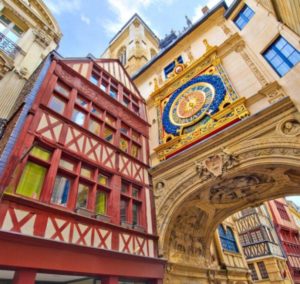
Situated on the banks of the river Seine, Rouen is the capital of the Haute Normandie region. An active port and commercial city even in the Roman era and Middle ages, Rouen has a number of ornate Gothic churches, beautiful medieval half-timbered houses, a cobblestoned pedestrian centre and its famous astronomical clock. Even if you’ve never been there, you’ll likely to recognise its Cathedral of Notre Dame from the numerous paintings of Claude Monet and J.M.W. Turner, and of course, know it as the place where Joan of Arc was burned at the stake in 1431. As well as its long, and often turbulent history, Rouen is also a modern city known for its art, culture and excellent food.

Described by Victor Hugo as the city of ‘a hundred spires’, Rouen is one of Normandy’s most engaging and historically rich destinations. It was devastated by plague and fire several times during the Middle Ages, and was occupied by the English during the Hundred Years War, and by WWll Allied bombing raids that laid waste to large parts of the city south of the Cathedral.
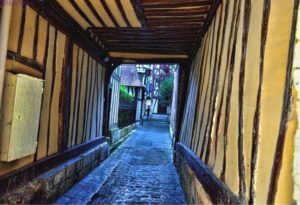
Rouen was founded by the Gaulish tribe of the Veliocasses who controlled a large part of the lower Seine valley. It was eventually taken over by the Romans to become the second city of Roman Gaul after Lugdunum (Lyon). Under the Emperor Diocletian, the city was endowed with a fine amphitheatre seating 3,000 and a thermae (bath complex) of which some foundations remain. In the 5th century, it became the seat of a bishopric and later, a capital of the Merovingian dynasty.
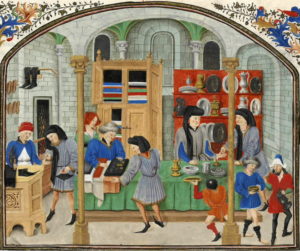
Rouen was the seat of the Exchequer of Normandy during the Middle Ages, and was one of the capitals of the Anglo-Norman dynasties which ruled both England and large parts of modern-day France, for about 500 years from the 11th century. The city enjoyed an economic boom from the 13th century onwards, due to the establishment of textile factories and river trade. Thanks to the wealth generated by trade, particularly from the Champagne Fairs, it had considerable prestige as a seat of power for the Dukes of Normandy until William the Conqueror moved his residence to Caen—where he died and was buried in 1087, having suffered an accident while leading a campaign. Despite having been abandoned by William, Rouen went on to become an important archdiocese, with a Court of Appeal and a university, all of which ensured that the city developed a rich architectural heritage through its historical monuments, and helped establish Rouen as an important cultural capital.
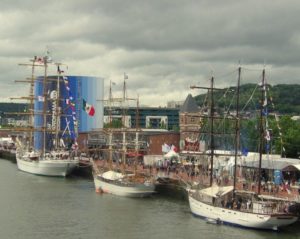
Rouen not only celebrates its architectural heritage, but also its maritime history. About every four years the city hosts a large gathering of historic sailing ships called “L’Armada”, and for its 11 day duration in June, this events makes Rouen something of a capital of the maritime trading world. When you walk along the quays it’s not hard to imagine the many invasions that came from the sea. This flotilla of historic vessels is yet another, albeit peaceful one, and this city has seen it all.
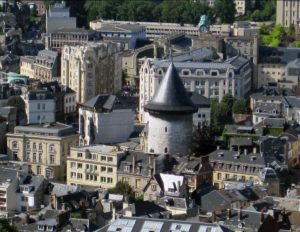
In the 13th century, King Philip ll of France annexed Normandy to the French Kingdom. He demolished the Norman castle and replaced it with his own, the Château de Bouvreuil, built on the site of the Gallo-Roman amphitheatre. All but the donjon (keep) was dismantled in 1591. Known today as the Tour Jeanne d’Arc, the donjon housed one of the sessions of Joan’s trial on 09 May 1431.
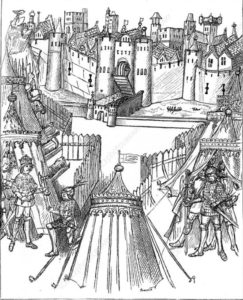
The city continued to have a turbulent history. In January 1419, during the Hundred Years’ War, Rouen surrendered to Henry V of England, who annexed Normandy once again to the Plantagenet domains.
However, Rouen did not go quietly, with the city being tossed between the French and the English until Joan of Arc, who supported a return to French rule, was burned at the stake on 30 May 1431 in the city, at a time when most of the inhabitants supported the Duke of Burgundy, the French King’s arch enemy. Ultimately, the king of France, Charles Vll recaptured the town in 1449.
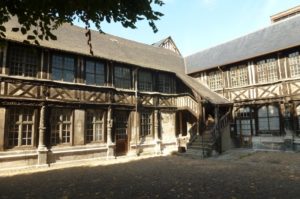
Like much of Europe at the time, Rouen experienced a deadly plague in the 14th century, and one of the most interesting sites to visit is L’Aitre Saint-Maclou, which was established by an order of monks as a quarantine centre as well as a cemetery where plague victims were buried.
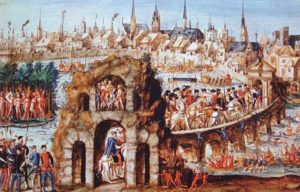
The city suffered further upheaval in the 16th century since it was staunchly Catholic during the French Wars of Religion. It endured a 5 month siege in 1591-2 by the Protestant King Henri lV of France and an English army commanded by Robert Devereux, the Earl of Essex and favourite of Elizabeth l.
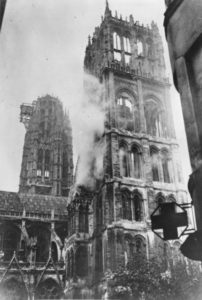
Rouen has certainly known foreign occupation over the centuries. During the Franco-Prussian War of 1870, Rouen was occupied by the Prussians. Throughout WWl the British used Rouen as a supply base, and there were many military hospitals here. The city was heavily damaged during WWll, and in June 1940, the area between the great Gothic cathedral of Notre-Dame and the river Seine burned for 48 hours because the Germans refused firemen access to extinguish it. Yet more damage occurred during the Battle of Normandy, which ended on the city’s left bank of the river Seine, with the destruction of several German regiments and many significant buildings, including parts of the cathedral. During the German occupation, the German Navy had its headquarters in a château which is now the Rouen Business School.
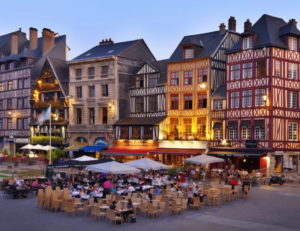
There are about 2,000 original half-timbered houses in Rouen, around 200 of which date back to the early Middle Ages.
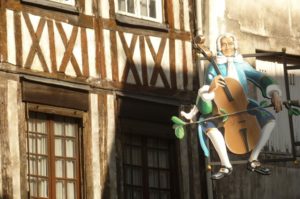
Strong heritage laws protect these historic buildings, and many are continuing their original function as private residences or commercial use, rather than having to be converted to museums or other, non-traditional functions. As a result, Rouen has enjoyed an almost unbroken history of authenticity and continuity as a busy and vibrant city.
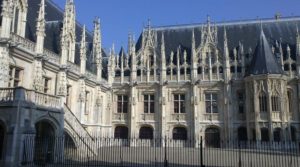
Among the wealth of architectural treasures of the city, you can’t miss the Palais de Justice. Built in a mixture of the French Flamboyant and Renaissance styles under the reign of Louis Xll between 1499 and 1508, it served firstly as a royal palace, later becoming the provincial Parlement de Normandie up until the Revolution, replacing the ancient court of the exchequer of Normandy, set up by the first Duke. Today, it’s the seat of the Law Courts. In 1976, a major Jewish monument was discovered under the Palais courtyard that dates back to the 12th century. The entrance to this monument is named in Hebrew and translates as ‘Sublime Abode’. It’s not known whether it was a college or a synagogue, or even the residence of a wealthy merchant or trader.
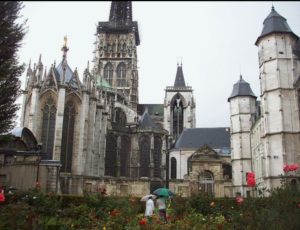
The most famous historic building of Rouen, without doubt, is the Cathedral of Notre-Dame—officially the Cathédrale primatiale Notre-Dame de l’Assomption de Rouen—is a glorious, flamboyant, Gothic extravaganza. It is the See of the Archbishop of Rouen, Primate of Normandy. Built on the site of an earlier building dating back to the 4th century, the current cathedral was commenced in 1200 and reconstructed after a fire. It had a number of changes again in the 15th and 16th centuries, and a number of natural disasters such as being struck by lightning in 1625 and 1642, then damaged by a hurricane in 1683.
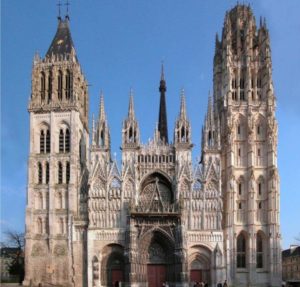
The cathedral is famous for its 3 towers, each in a different style. The Saint-Romain tower, on the left facing the western front, was begun in 1145 as part of the original Gothic cathedral. It houses the bourdon or largest Cathedral bell, named Joan of Arc, as well as 64 smaller bells making up the carillon, which was restored in 2016, and is the 2nd largest carillon in France.
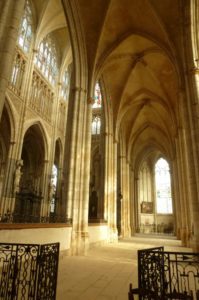
The Tour du Beurre (Butter Tower), on the right was built between 1488 and 1506 in the late Gothic Flamboyant style. Its name came about because donors to the tower were given a dispensation to consume butter and milk during Lent.
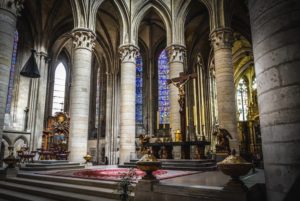
The middle tower of the three, over the crossing, is called the Lantern Tower and Spire (flèche). Built of iron, the spire was built in the 19th century after lightning started a fire that destroyed the timber and lead of the Renaissance spire. At an incredible 151m high, it’s the tallest of the three towers, and the addition of this new spire briefly qualified it as the tallest building in the world, until the completion of Cologne Cathedral in 1880. At the time, the idea of an iron and copper spire was highly controversial—the novelist Gustave Flaubert denounced it as “the dream of a metal-worker in a delirium”.
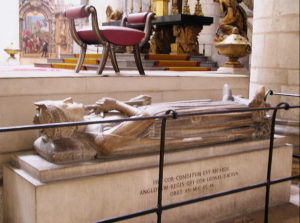
The interior is elegantly simple, the soaring columns take your eyes upward, and it’s full of treasures. The heart of Charles V is preserved in a coffer in the 11th century crypt, while the heart of Richard the Lionheart is within a tomb located in the ambulatory around the choir. He loved Rouen so much that he requested this his heart stay here in the cathedral choir. The exquisite rose window of the north portal is original, dating from the end of the 14th century, while the windows in the north side of the nave and in the transept are early 13th century.
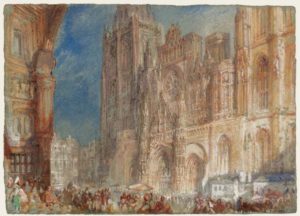
In 1796 the new revolutionary government nationalised the cathedral and transformed it for a time into a Temple of Reason. Some of the furniture and sculpture was sold, and the chapel fences were melted down to make cannons.
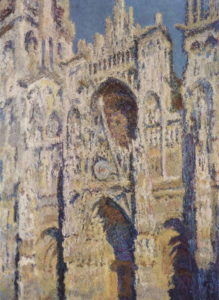
Even if you’ve never visited Rouen before, the image of its cathedral will likely be very familiar. Claude Monet was entranced by the different effects of light on the façade of the cathedral at varying times of the day, and produced a series of around 28 paintings of it. Or perhaps you’ve seen the many unforgettable paintings by JMW Turner from around 1832 of Rouen Cathedral in London’s Tate Gallery.
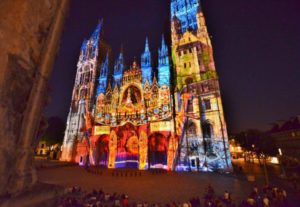
If you plan a visit to Rouen between June and September, you can catch the dazzling Son-et-Lumiere show that’s projected onto the façade of the cathedral every evening, for 50 mins., twice each night. It’s a must-see summer event, and each year has a different historical theme.
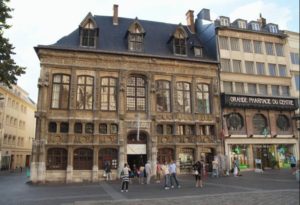
Opposite the cathedral you’ll find the Tourist Office housed in a lovely old Renaissance building that was once the Bureau de Finances, built in 1510. They can provide you with a map to guide you through Old Rouen, as well as other useful info. Stroll in any direction through the narrow streets with their 15th-18th century buildings. To the west of the cathedral, you’ll pass by the Palais de Justice, already mentioned above, in rue des Juifs.
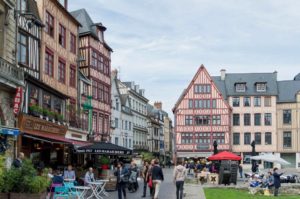
A little further on is the Place du Vieux-Marché, which historically was the main meeting and entertainment centre during the Middle Ages. One of the favourite forms of “entertainment” for the local crowd attending the daily market was to join in the fun of hurling rotten vegetables at the unfortunates locked in the stocks. It was also the place for public executions, of which the most famous would have to have been Joan of Arc, who was burned at the stake for heresy, in 1431, during the Hundred Years’ War.
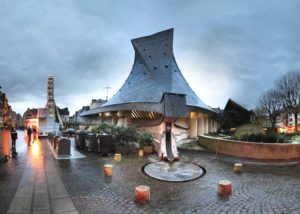
There is a modern church of St Joan of Arc on the Place du Vieux-Marché, which comes as something of a visual shock among the medieval buildings of the city’s historic centre—it’s certainly not the prettiest building in town! Completed in 1979, it looks like an upturned ship—supposedly serving as a reminder of the importance to the city of the sea and river traffic along the Seine. However, do go inside to view the 13 panels of superb 16th century Renaissance stained glass, rescued from the Church of St Vincent after it was bombed in 1944.
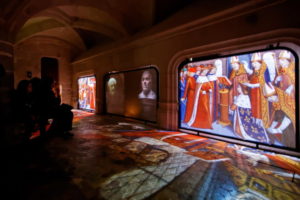
Just north of the cathedral, at 7 rue Saint-Romain, at the archbishop’s palace, is the excellent History of Joan of Arc (Historial Jeanne d’Arc) Museum, where her extraordinary story—as historical figure, myth and religious icon—is told through the medium of holographs, right up to her posthumous pardon in 1456. Visitors view screens in a succession of rooms, and the medieval buildings encompass a dungeon where she was threatened with torture, and the Archbishop’s Palace, where her trial took place. One-hour visits of 25 visitors run continuously, the precise departure of each group synchronised to the venue’s multimedia devices. In order to avoid waiting, you can simply reserve your desired time slot online and print out your ticket.
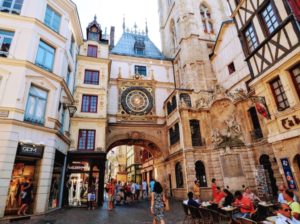
At rue du Gros-Horloge, which connects the Vieux Marché to the cathedral, you’ll walk under Rouen’s most popular monument: the 14th century astronomical clock. The spectacular Gros Horloge, or great clock, is one of the country’s most beautiful objects from the Middle Ages. It also served a practical purpose at a time when nobody had clocks or watches. The single hand tells the hours, the central section tells the phases of the moon, and the lower part shows the weeks. The rue du Gros Horloge is one of Rouen’s main shopping streets, lined with half-timbered houses, some of which still have visible damage from WWll.

The Musée des Beaux-Arts de Rouen has one of France’s best collections of Impressionist paintings and more, housed in an impressive 19th century building. There are works by Caravaggio, Velasquez and Rubens, but the highlight of the collection are the stunning works by Ingres, Monet, David, Gericault, Degas, Millet, Renoir and Pissarro. A very generous donation in 1909 made this art museum second only to the Musée d’Orsay in Paris for its Impressionist collection.
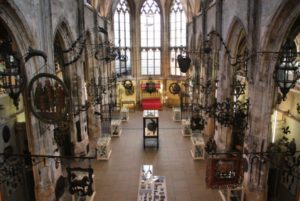
Another interesting stop is located in the decommissioned Church of Saint-Laurent in rue Jacques-Villon. Nowadays, it serves as an antique ironwork museum with shop and pub signs, tools, ornate hangars and even jewellery dating back to the 1500s. The official name of the museum is Musée Le Secq des Tournelles, named after the collector of the same name, a painter who studied in Paris and Rome, and who became one of the first photographers in France. He donated his collection of ironwork to the museum in the 1920s.
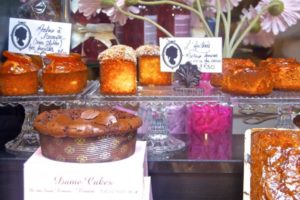
Don’t leave Rouen without feasting your eyes on the seasonal produce and all sorts of local delicacies such as Normandy cakes, fresh mounds of salted butter, cheeses, freshly caught Normandy seafood or beautiful flowers at one of the city’s 12 different outdoor local produce markets, some of which, on certain days, sell bric-a-brac and antiques.
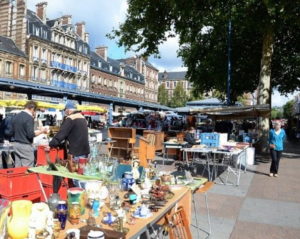
The Marché de Clos Saint-Marc, located in Place Saint-Marc, is the largest market in Rouen and offers a wide variety of local goods Tuesday to Sunday, and has a flea market on Fridays and Saturdays. The Vieux-Marché in Rouen’s Old Market Square has stalls selling fresh produce and flowers on Tuesday-Sunday and on Saturday is the site of a flea market.
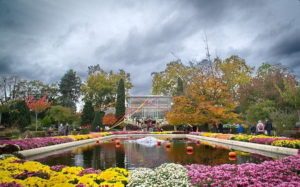
Just outside the centre of Rouen in rue de Trianon, spread over 10 hectares is the Jardin des Plantes, the ideal spot for a gentle stroll and a little relaxation. This botanical garden is a year-round garden. It celebrates spring with irises, wisteria, camellias and rhododendrons. In summer, the air is full of the scent of hundreds of roses; autumn has wonderful foliage colours and gold chrysanthemums, and in winter, you can explore the tropical hothouses for more exotic plants and flowers.
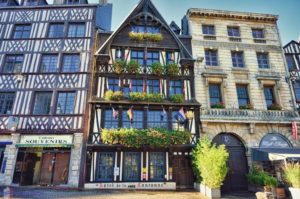
Rouen is one of the most rewarding cities in France, with a wealth of beautiful, historic buildings and monuments and medieval streets to wander, excellent museums to visit, good outdoor markets and an outstanding Jardin des Plantes. If you’ve time, or you’re staying overnight, book a table at ‘La Couronne’. This restaurant, founded in 1345, claims to be France’s oldest inn.
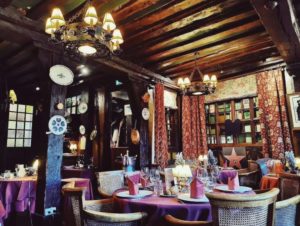
You can feast shamelessly on a fabulous local, old-world dish, Rouen duckling—caneton a la rouennaise—which is cooked at your table in port, cognac and red wine, plus the bird’s blood, pressed liver and heart. The restaurant was a big hit with the giants of old Hollywood, and their signed portraits adorn its many floors. For great seafood, head to Gill, at 8 Quai de la Bourse, a two-star Michelin restaurant that focuses on fresh seafood from the waters of the Normandy coast, featuring classics of Norman gastronomy such as turbot cooked in apple cider, local oysters and roasted local lobster.
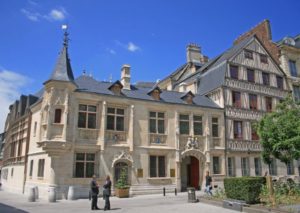
Getting to Rouen is very easy. From Paris by train it takes approx. an hour and a half on a direct train from Gare St Lazare to Rouen-Rive-Droite. There are trains about every half an hr. By car, it takes around 2 hrs. to cover the 136kms.
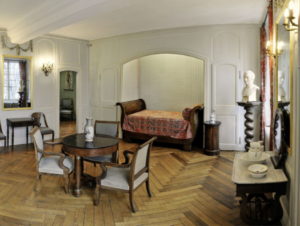
It’s do-able just for a day trip, or en route to other parts of Normandy, and there’s plenty of accommodation, ranging from apartments to hotels. One interesting hotel is the 4 star Hôtel Littéraire Gustave Flaubert. The author of ‘Madame Bovary’ and other great works was born in Rouen in 1821. His birthplace can be visited at 51, rue de Lecat, which is a literary and medical museum (Flaubert’s father was a doctor), and features curiosities such as a six-patient bed and a “leech perch” (no, don’t ask!).
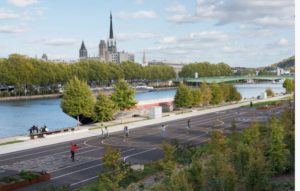
The ideal location to stay is to aim for as close to the centre as you can get, but if you’re driving, check if there’s parking available, as parking in the centre of any historic city can be quite a challenge—and that’s certainly the case with Rouen!


Thanks, Cheryl. As always, I can hardly wait to see this for myself .
Hi Lois,
Glad you enjoyed reading about Rouen. Last time we were there it had been decades since our previous visit, and we were thrilled that there were so many new things to see, plus yet more of their outstanding historic buildings restored so well, yet at the same time, the essence of the city remains the same. Like you, can’t wait to re-visit! Cheers for now, Cheryl